The Sai Baba Evening Aarti, also known as Dhoop Aarti, is a sacred devotion performed at sunset, available in PDF formats in multiple languages like Bengali, English, Gujarati, and Hindi, offering spiritual and cultural significance to devotees worldwide.
Overview of Sai Baba Evening Aarti
The Sai Baba Evening Aarti, also known as Dhoop Aarti, is a sacred ritual performed at sunset, symbolizing the offering of light and prayers to Sai Baba. It is a serene devotion that marks the end of the day, fostering spiritual reflection and inner peace. The Aarti is available in multiple languages, including Bengali, English, Gujarati, Hindi, and more, making it accessible to a diverse community of devotees. The lyrics, often accompanied by soothing melodies, express devotion, gratitude, and surrender to the divine. PDF versions of the Aarti are widely available for download, enabling devotees to practice and chant effortlessly, deepening their spiritual connection.
Importance of Evening Aarti in Worship
The Evening Aarti holds profound significance in worship, serving as a bridge between the divine and the devotee. Performed at sunset, it symbolizes the culmination of daily rituals, offering a moment of introspection and surrender. The Aarti’s lyrics, available in multiple languages as PDF downloads, convey deep devotion and spiritual longing. It fosters a sense of community among worshippers, creating a collective energy of faith and harmony. Additionally, chanting the Aarti is believed to purify the mind, bring emotional balance, and strengthen one’s connection with Sai Baba’s teachings. Its practice is a powerful way to seek blessings and experience inner peace.
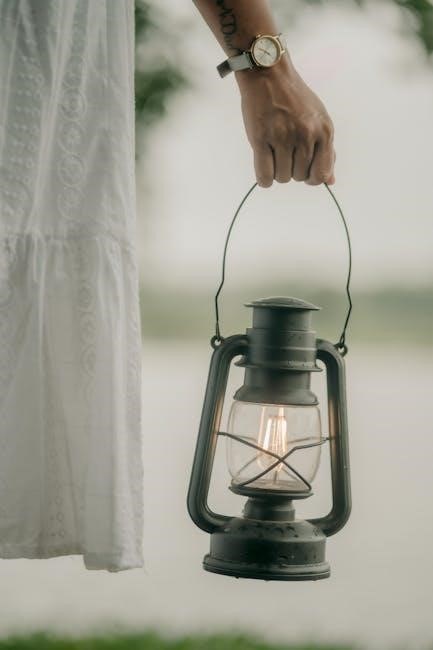
Structure and Rhythm of the Aarti
The Sai Baba Evening Aarti features a poetic composition with a soothing melody, performed at sunset, incorporating traditional instruments like the drum and cymbals, creating a rhythmic harmony that fosters spiritual connection.
poetic Composition and Melody
The poetic composition of the Sai Baba Evening Aarti is deeply devotional, blending lyrical elegance with spiritual emotion. The lyrics, often written in simple yet profound language, follow a traditional rhyme scheme, making them easy to recite and chant. The melody is soothing and rhythmic, designed to evoke a sense of calm and connection with the divine. Instrumental accompaniments like the harmonium, tabla, and tanpura enhance the musicality, creating a harmonious blend of sound and spirit. This combination of poetic depth and melodic beauty ensures the Aarti resonates with devotees, fostering a profound sense of devotion and inner peace during the evening ritual.
Traditional and Modern Variations
The Sai Baba Evening Aarti is performed in both traditional and modern formats, reflecting its timeless appeal. Traditional versions adhere to classical Indian musical elements, featuring instruments like the harmonium and tabla, and are often sung in temples with simple, devotional melodies. In contrast, modern variations incorporate contemporary music styles, such as orchestral arrangements or fusion tunes, making the Aarti resonate with younger audiences. Regional influences also play a role, with variations incorporating local musical traditions. These adaptations ensure the Aarti remains relevant while preserving its spiritual essence, allowing devotees across generations and cultures to connect with Sai Baba’s teachings through music.
Translations of Sai Baba Evening Aarti
The Sai Baba Evening Aarti is available in multiple languages, including English, Bengali, Gujarati, Hindi, Telugu, Oriya, and Tamil, catering to devotees across cultural and linguistic boundaries.
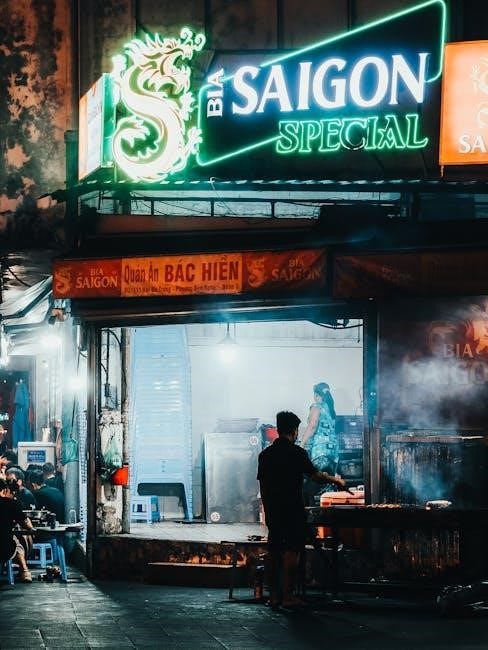
Bengali Translation and Significance
The Bengali translation of the Sai Baba Evening Aarti is deeply revered, offering devotees in Bengal and beyond a meaningful way to connect with Sai Baba’s teachings. The lyrics, rendered in the poetic Bengali language, capture the essence of devotion and spirituality. This translation bridges cultural and linguistic gaps, making the Aarti accessible to a wider audience. It is often downloaded as a PDF for personal and communal worship, ensuring its reach extends to both urban and rural areas. The Bengali version retains the original emotional depth, fostering a sense of unity and spiritual harmony among followers. Its significance lies in preserving the Aarti’s universal message while embracing regional cultural practices.
English Translation for Global Devotees
The English translation of Sai Baba’s Evening Aarti has become a vital resource for global devotees, enabling them to connect with the spiritual essence of the prayer irrespective of their linguistic background. Widely available as a PDF download, this translation ensures accessibility to millions worldwide. It bridges cultural and linguistic barriers, allowing devotees from diverse regions to experience the profound devotion embedded in the Aarti. The English version retains the spiritual depth and emotional resonance of the original, making it a unifying force for followers across the globe. This translation has played a crucial role in spreading Sai Baba’s teachings and fostering a sense of universal harmony among devotees.
Gujarati Translation and Cultural Impact
The Gujarati translation of Sai Baba’s Evening Aarti has deeply resonated with devotees in Gujarat and beyond, fostering a strong spiritual connection. This version seamlessly blends the original Marathi composition with Gujarati’s linguistic nuances, ensuring the emotional and devotional essence remains intact. The translation has played a significant role in spreading Sai Baba’s teachings across Gujarat and among Gujarati-speaking communities worldwide. Available as a PDF download, it has become a cherished resource for personal and communal worship. The Gujarati Aarti not only preserves cultural heritage but also unites devotees through its melodious and meaningful rendition, enhancing its cultural and spiritual impact.
Hindi Version and Its Popularity
The Hindi version of Sai Baba’s Evening Aarti is widely revered and cherished across India, particularly in North India, where Hindi is the predominant language. Its simple yet profound lyrics resonate deeply with devotees, making it a central part of daily worship. The Hindi translation captures the essence of the original Marathi Aarti, preserving its spiritual and emotional depth. Its popularity stems from its accessibility and the strong emotional connection it fosters. Available as a PDF download, the Hindi Aarti is widely shared and recited in temples, homes, and community gatherings. This version has become a cornerstone of Sai Baba worship, uniting millions in devotion and spirituality.
Telugu Translation and Regional Significance
The Telugu translation of Sai Baba Evening Aarti holds immense cultural and spiritual significance in the southern regions of India, particularly in Andhra Pradesh and Telangana. Devotees in these areas deeply connect with the Telugu lyrics, which beautifully capture the essence of devotion and reverence for Sai Baba. The translation is widely accessed through PDF formats, making it easily available for recitation in both personal and communal worship. It serves as a bridge between traditional and modern spiritual practices, fostering a sense of unity among Telugu-speaking followers. This version is cherished for its emotional depth and its role in preserving regional devotional traditions.
Oriya Translation and Local Practices
The Oriya translation of Sai Baba Evening Aarti is deeply cherished by devotees in Odisha and other Oriya-speaking regions. It seamlessly blends the spiritual essence of the original composition with the cultural nuances of the locality. Local practices often involve chanting the Aarti during evening prayers, accompanied by traditional instruments like the harmonium and cymbals. The PDF versions of the Oriya Aarti are widely circulated, making it accessible for devotees to recite during personal devotion or communal gatherings. This translation plays a vital role in preserving the spiritual heritage while fostering a sense of unity and devotion among the local community.
Tamil Translation and Devotional Aspect
The Tamil translation of Sai Baba Evening Aarti holds immense cultural and spiritual significance, resonating deeply with devotees in Tamil Nadu and beyond. PDF versions of the Tamil Aarti are widely sought after, offering easy access for daily worship. The translation beautifully captures the essence of devotion, blending traditional Tamil Bhakti with Sai Baba’s universal teachings. Locals incorporate the Aarti into temple rituals and home prayers, fostering a sense of community and spiritual connection. Its melodious rendition, enriched with Tamil cultural elements, enhances the devotional experience, making it a cherished part of spiritual practices for millions of Tamil-speaking Sai Baba followers.
Significance of Evening Aarti
The Evening Aarti marks the transition from day to night, fostering reflection and seeking blessings. It connects devotees to spiritual traditions and strengthens community bonds.
Spiritual Importance at Sunset
The Sai Baba Evening Aarti holds profound spiritual significance at sunset, symbolizing the dissolution of the ego and union with the divine. As day transitions to night, it represents a moment of surrender and gratitude. Devotees believe this sacred time bridges the material and spiritual worlds, offering a chance to reflect on daily actions and seek divine blessings. The Aarti’s lyrics, rich in devotion, create a meditative atmosphere, calming the mind and fostering a deeper connection with Sai Baba’s teachings. It is a moment to let go of worldly attachments and immerse in spiritual bliss, seeking peace and guidance for the night ahead.
Cultural Relevance in India
The Sai Baba Evening Aarti holds deep cultural significance in India, reflecting the country’s rich spiritual and devotional heritage. It is a cornerstone of communal worship, fostering unity and emotional bonding among devotees. The Aarti is often sung in temples, homes, and public gatherings, blending traditional melodies with heartfelt lyrics. Its cultural impact is evident in its adaptation into various regional languages and musical styles, making it accessible to diverse populations. The Evening Aarti embodies India’s vibrant tradition of bhakti (devotion), serving as a bridge between the divine and humanity. It continues to inspire countless devotees, reinforcing its timeless cultural and spiritual value.

History and Origins
The Sai Baba Evening Aarti traces its origins to Sai Baba’s life in Shirdi during the late 19th and early 20th centuries. Composed by devotees, it became central to post-1918 rituals, spreading his teachings and uniting the spiritual community.
Origins of the Sai Baba Aarti
The Sai Baba Evening Aarti has its roots in the life and teachings of Sai Baba of Shirdi, a revered spiritual leader in India. The Aarti was composed by his devotees as a devotional hymn to express their reverence and gratitude. It was written in Marathi, reflecting the regional language and culture of Maharashtra, where Shirdi is located. The lyrics were created after Sai Baba’s passing in 1918, becoming a central part of rituals at the Shirdi temple. The Aarti is sung to glorify Sai Baba’s divine qualities and teachings, emphasizing his role as a spiritual guide and symbol of unity.
The origins of the Aarti are deeply tied to the community of devotees who sought to preserve Sai Baba’s legacy through music and prayer. Over time, it has evolved into a universal prayer, transcending regional boundaries, with translations in multiple languages, including English, Bengali, and Gujarati. The Evening Aarti is traditionally performed at sunset, marking the end of the day and the beginning of a period of introspection and spiritual reflection. Its melodic and poetic composition has made it a cherished part of Sai Baba worship worldwide, fostering a sense of connection among devotees across cultures and languages.
Evolution Over Time
The Sai Baba Evening Aarti has undergone significant evolution since its inception, adapting to cultural and technological advancements. Initially performed in Marathi, it has been translated into multiple languages, broadening its reach. Musical renditions have incorporated diverse instruments and styles, blending traditional and contemporary melodies. Digital platforms now offer downloadable PDF versions, making the lyrics and rituals accessible globally. Over time, the Aarti has become a universal prayer, uniting devotees across cultures and generations. Its evolution reflects the dynamic nature of devotion while preserving the core spiritual essence of Sai Baba’s teachings.
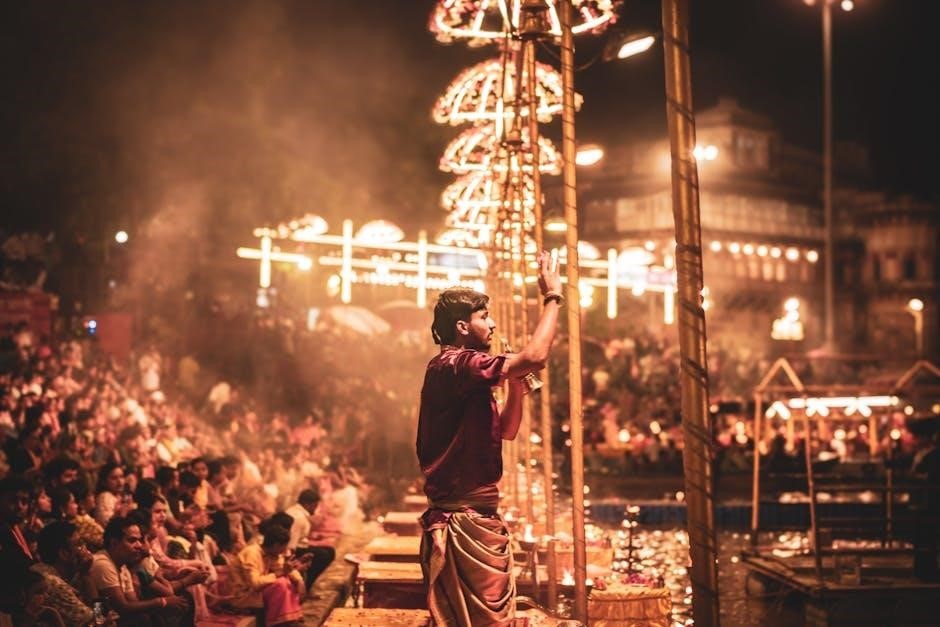
Cultural Impact and Devotional Use

The Sai Baba Evening Aarti deeply influences Indian culture, unifying devotees across regions. Its devotional use strengthens spiritual practices, making it a cherished part of daily worship rituals.
Role in Community Worship
The Sai Baba Evening Aarti plays a vital role in community worship, fostering unity among devotees. It is often performed collectively in temples and homes, creating a shared spiritual experience. The rhythmic chanting and singing of the aarti lyrics bring people together, strengthening communal bonds. Many temples incorporate the aarti into their daily rituals, making it a cornerstone of group worship. This collective participation not only enhances devotion but also promotes a sense of belonging and harmony among worshippers. The aarti’s universal appeal ensures its continued relevance in community practices, making it a timeless tradition in Sai Baba’s worship.
Use in Personal Devotion
The Sai Baba Evening Aarti holds profound significance in personal devotion, offering a means to connect with the divine. Many devotees incorporate the aarti into their daily routines, reciting its lyrics during personal prayer or meditation. The poetic verses evoke feelings of reverence and introspection, helping individuals seek inner peace and spiritual alignment. By chanting the aarti, devotees express gratitude and seek blessings, fostering a deeper personal relationship with Sai Baba. Its melodious rhythm and meaningful words make it a powerful tool for personal worship, providing solace and guidance in daily life. This practice strengthens faith and nurtures emotional well-being.
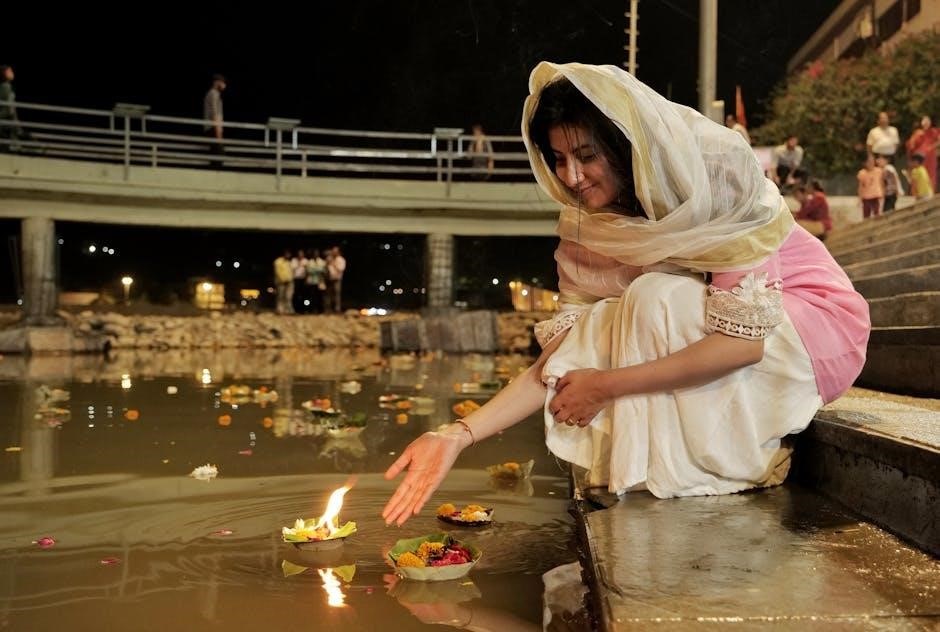
Benefits of Chanting the Aarti
Chanting the Sai Baba Evening Aarti brings peace, spiritual growth, and positive energy, fostering emotional relief and a deeper connection to the divine, enriching one’s life profoundly always.
Spiritual Benefits for Devotees
Chanting the Sai Baba Evening Aarti offers profound spiritual benefits, fostering a deep connection with the divine. It cleanses the soul, calms the mind, and strengthens faith, helping devotees seek divine grace and blessings. The sacred hymns evoke feelings of devotion and surrender, aligning one’s thoughts and actions with divine will. Regular chanting enhances spiritual growth, providing inner peace and clarity. It also serves as a medium to express gratitude and seek guidance, creating a sense of unity with the universe. The Aarti’s spiritual vibrations uplift the heart, making it a powerful practice for seekers of divine truth and enlightenment.
Emotional and Mental Well-being
Engaging in the Sai Baba Evening Aarti promotes emotional and mental well-being by fostering a sense of calm and community. The rhythmic chanting acts as a meditative practice, reducing stress and anxiety, and enhancing mental clarity. Singing collectively with others releases endorphins, uplifting the mood and providing comfort. This traditional practice offers a sense of continuity and belonging, crucial for emotional stability. By participating in the aarti, devotees can achieve a balanced mental state and overall well-being in their daily lives, making it a powerful tool for maintaining emotional and mental harmony.
Role in Sai Baba Worship
The Sai Baba Evening Aarti holds a central position in worship rituals, connecting devotees with Sai Baba’s divine presence and teachings. It is performed collectively to seek blessings and express gratitude, embodying the essence of devotion and community faith. The aarti serves as a bridge between the spiritual and the material, fostering a deeper connection with Sai Baba’s philosophy and guiding principles. Its recitation is a powerful way to honor Sai Baba and experience spiritual unity.
Central Place in Rituals
The Sai Baba Evening Aarti occupies a central place in daily worship rituals, performed at sunset to signify the end of the day and the beginning of night. It is a collective prayer sung by devotees to express gratitude and seek blessings from Sai Baba. The aarti is accompanied by the lighting of lamps and the offering of prayers, symbolizing the illumination of the soul. This ritual is deeply ingrained in the spiritual practices of Sai Baba’s followers, serving as a unifying experience that strengthens faith and devotion. Its melodious chants and heartfelt recitation create a sacred atmosphere, fostering a profound connection with the divine.
Connection with Sai Baba’s Teachings
The Sai Baba Evening Aarti deeply resonates with the spiritual teachings of Sai Baba, emphasizing devotion, faith, and self-surrender. The lyrics reflect his core philosophies, such as the importance of patience (“shraddha” and “saburi”) and the pursuit of inner peace. By chanting the aarti, devotees connect with Sai Baba’s divine energy and reaffirm their commitment to his teachings. The practice encourages mindfulness and humility, aligning with Sai Baba’s message of universal love and unity. The aarti serves as a bridge between the devotee and the divine, fostering a deeper understanding of Sai Baba’s wisdom and its application in daily life.
How to Perform the Aarti
Light a lamp, offer incense and flowers, and chant the Sai Baba Evening Aarti lyrics with devotion. Perform it at sunset facing the deity, ensuring a peaceful ambiance for spiritual connection.
Preparation and Rituals
Prepare for the Sai Baba Evening Aarti by cleansing the space, lighting a lamp, and arranging offerings like flowers and incense. Place Sai Baba’s image or photo on an altar, ensuring a serene atmosphere. Begin by chanting “Om Sai Ram” to invoke blessings. Offer flowers and light the lamp, symbolizing the dispelling of darkness. Recite the aarti lyrics with devotion, maintaining rhythm and focus. Conclude with prasad distribution, signifying divine grace. These rituals create a sacred connection, fostering spiritual harmony and mindfulness during the ceremony.
Practices During the Ceremony
During the Sai Baba Evening Aarti, devotees stand with folded hands, singing the lyrics in unison. The aarti is performed with a lamp, which is circled around Sai Baba’s image while chanting. Devotees often clap to maintain rhythm, creating a collective spiritual energy. The ceremony includes offering flowers and incense, symbolizing devotion and purity. After the aarti concludes, prasad is distributed to all participants, embodying divine blessings. The practice fosters unity and mindfulness, connecting devotees to Sai Baba’s teachings of love and faith. This collective worship strengthens spiritual bonds and reinforces the divine experience for all involved.
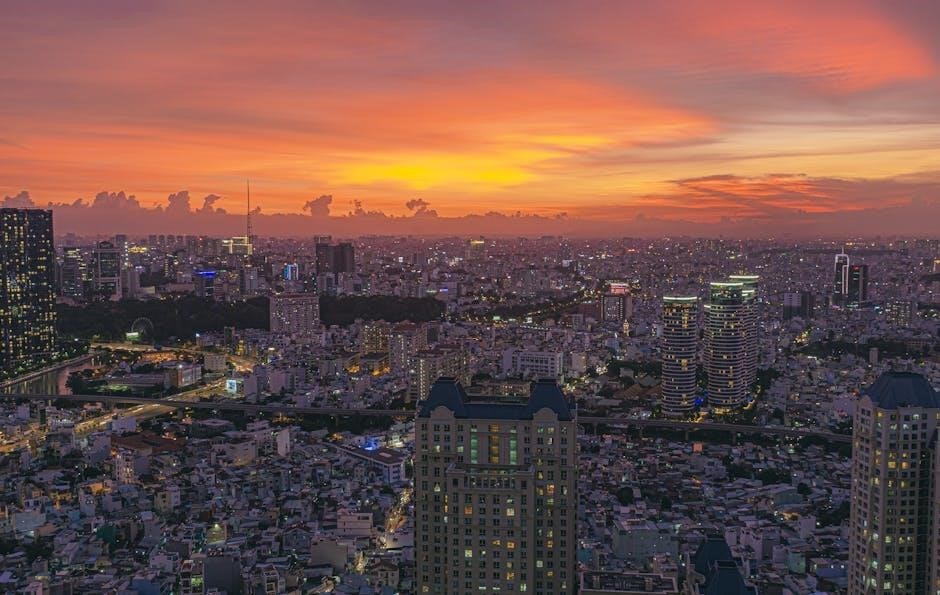
Role of Instruments in the Aarti
Traditional instruments like the harmonium, tabla, and dholak create a divine ambiance, enhancing the spiritual experience. Their rhythmic beats and soothing melodies elevate the aarti’s emotional impact.
Traditional Instruments Used
The Sai Baba Evening Aarti features traditional Indian instruments that resonate with spiritual vibrations. The harmonium, a reed organ, provides the primary melody, while the tabla and dholak add rhythmic beats. The veena, a stringed instrument, is occasionally used to enhance the devotional ambiance. Cymbals, known as jhanj or taal, are played to maintain rhythm and invoke divine presence. Sometimes, the flute is incorporated to create a serene atmosphere. These instruments collectively create a harmonious blend that elevates the aarti’s emotional and spiritual impact, making it a deeply immersive experience for devotees.
Impact of Instrumental Accompaniment
The instrumental accompaniment in Sai Baba Evening Aarti profoundly enhances its spiritual and emotional impact. The harmonium’s soulful melodies, combined with the rhythmic beats of the tabla and dholak, create a meditative atmosphere, drawing devotees closer to the divine. The use of traditional instruments fosters a sense of cultural and spiritual connection, elevating the aarti’s devotional essence. The synchronization of these instruments resonates deeply with the heart, helping devotees transcend worldly thoughts and immerse themselves in worship. This symphony of sound and rhythm becomes a powerful medium for expressing devotion and seeking spiritual solace, making the aarti a deeply moving experience.
Popular Versions and Variations
The Sai Baba Evening Aarti is rendered in diverse musical styles, from traditional to modern, featuring instruments like harmonium and tabla. Renowned artists have created soulful renditions, blending devotion with melody, making it accessible to a wide audience while preserving its sacred essence and emotional depth.
Famous Musical Renditions
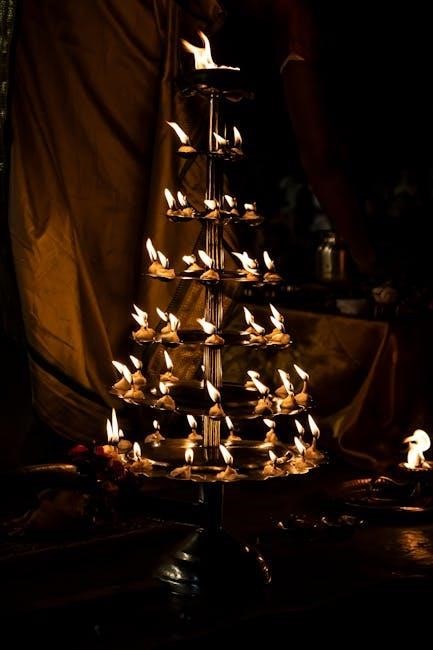
Renowned artists have created captivating versions of the Sai Baba Evening Aarti, blending traditional and contemporary styles. Notable renditions by singers like Anup Jalota and Suresh Wadkar have become widely popular, offering deep emotional resonance. These performances often feature classical instruments such as the harmonium, tabla, and tanpura, enhancing the spiritual ambiance. Modern adaptations incorporate orchestral arrangements, attracting younger audiences while preserving the Aarti’s essence. These renditions are frequently played in temples and homes, fostering a sense of devotion and unity among followers worldwide.
Regional Musical Variations
The Sai Baba Evening Aarti is performed with diverse musical styles across India, reflecting regional cultural influences. In South India, the Aarti often incorporates Carnatic classical notes and instruments like the veena or flute, creating a serene atmosphere. In North India, it is rendered with Hindustani classical ragas, accompanied by harmonium, tabla, and dholak. Eastern regions like Bengal and Odisha blend local folk tunes, while Gujarat infuses garba rhythms. These variations highlight the adaptability of the Aarti, making it accessible and relatable to devotees from different cultural backgrounds while maintaining its spiritual core and emotional depth.

Sources for PDF Downloads
Official Sai Baba temples and trusted spiritual websites offer free PDF downloads of the Evening Aarti lyrics. Platforms like Google Drive and Dropbox also host reliable versions for easy access and printing.
Reliable Websites for Download
Several trusted websites provide authentic Sai Baba Evening Aarti lyrics in PDF format. Official Shirdi Sai Baba temple websites are the most reliable sources, offering free downloads. Spiritual platforms like SaiBaba.Org and ShriSaibabaSansthan.org host verified PDF versions. Additionally, platforms like Google Drive and Dropbox often have community-shared PDFs. Ensure to verify the authenticity of the content before downloading from lesser-known sites to avoid inaccuracies.
Guidelines for Downloading
When downloading the Sai Baba Evening Aarti lyrics in PDF format, ensure you verify the source for authenticity. Stick to reputable websites and official temple platforms to avoid misinformation. Always check for the latest updated versions to access accurate content. Be mindful of copyright restrictions and respect intellectual property rights. Downloading for personal use or communal worship is encouraged, but avoid unauthorized distribution. Prioritize platforms with secure connections to protect your device from malware. Finally, review the content for accuracy before sharing or using it in rituals. Following these guidelines ensures a safe and meaningful experience for devotees worldwide.
The Sai Baba Evening Aarti lyrics PDF is a sacred resource, offering spiritual guidance and cultural enrichment. Its availability in multiple languages ensures global accessibility, fostering devotion and unity among followers worldwide. Downloading and reciting the Aarti deepens one’s connection to Sai Baba’s teachings, promoting peace and harmony. It is a timeless treasure for devotees seeking solace and inspiration in their spiritual journey. Embrace this divine offering and let its melody resonate in your heart forever.
Final Thoughts on the Aarti’s Significance
The Sai Baba Evening Aarti holds profound spiritual and cultural significance, serving as a bridge between devotees and the divine. Its lyrics, available in PDF formats, provide a convenient way to recite and reflect on the teachings of Sai Baba. The Aarti’s melodious chants and heartfelt words evoke emotions of devotion, peace, and surrender. It is a unifying force, bringing people together across cultures and languages. Downloading the PDF ensures accessibility, allowing devotees to practice the Aarti anytime, anywhere. This sacred hymn continues to inspire millions, fostering spiritual growth and a deeper connection to Sai Baba’s timeless wisdom and grace.
Encouragement for Participation
Participating in the Sai Baba Evening Aarti is a heartfelt way to connect with the divine and experience spiritual tranquility. The availability of the lyrics in PDF format makes it accessible to everyone, allowing devotees to recite and sing along with ease. Whether in a temple, at home, or with a community, joining in the Aarti fosters a sense of unity and devotion. Even those who feel shy or unsure can begin with the PDF, gradually immersing themselves in its sacred rhythm. Embrace this beautiful tradition and let its melodious verses guide you toward inner peace and a deeper divine connection.